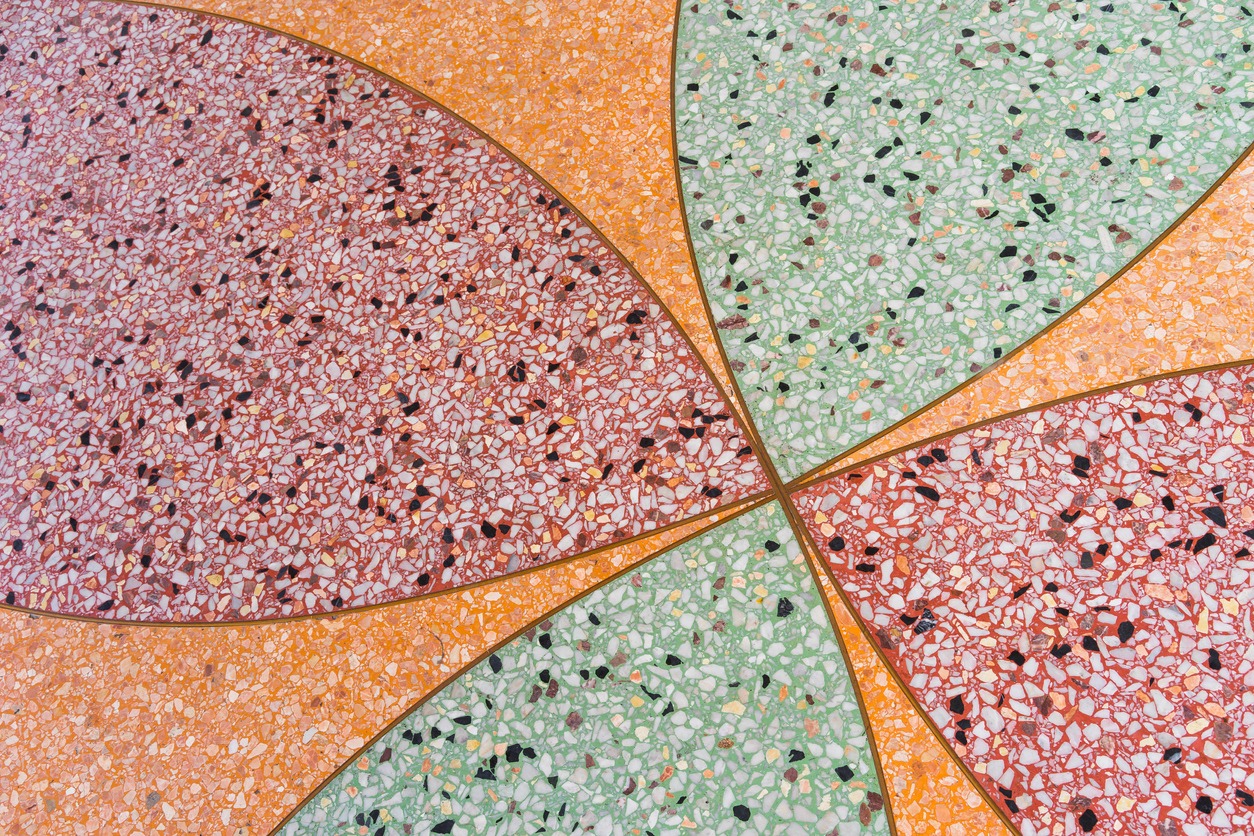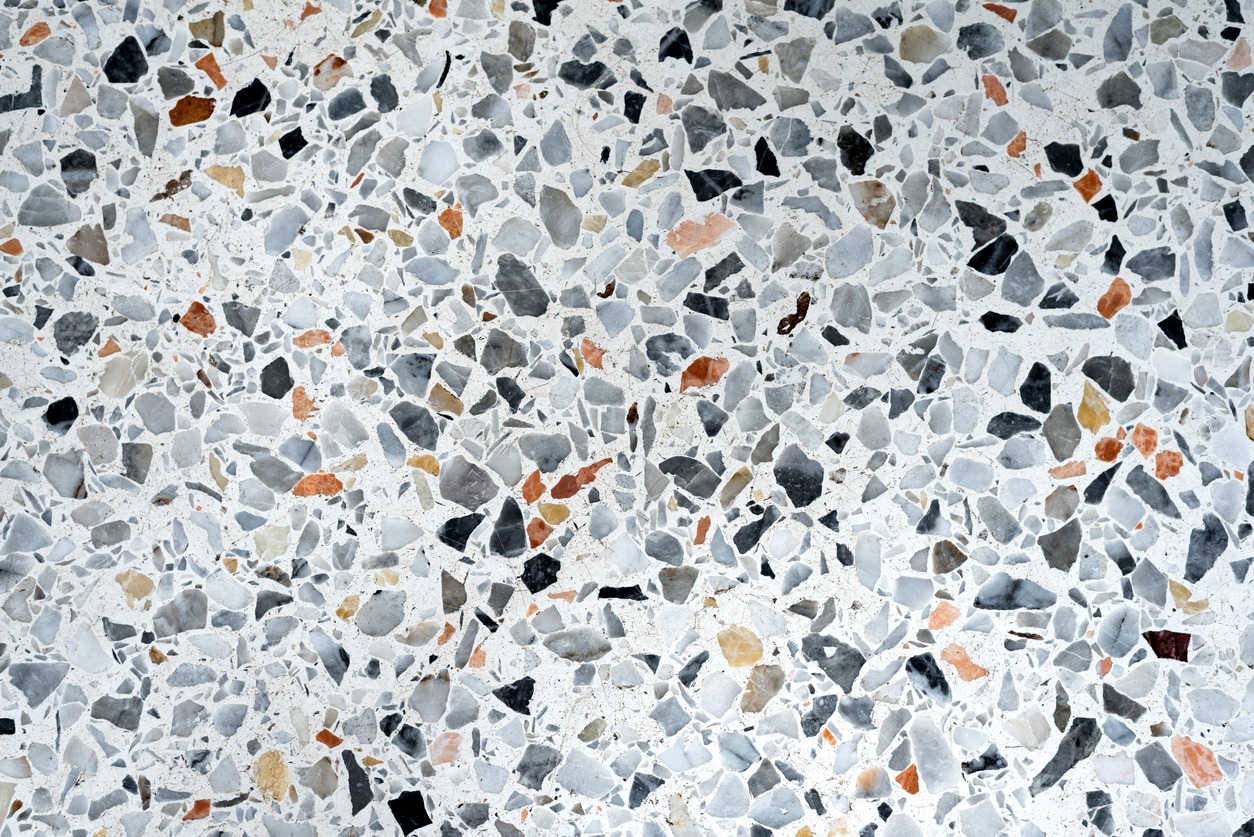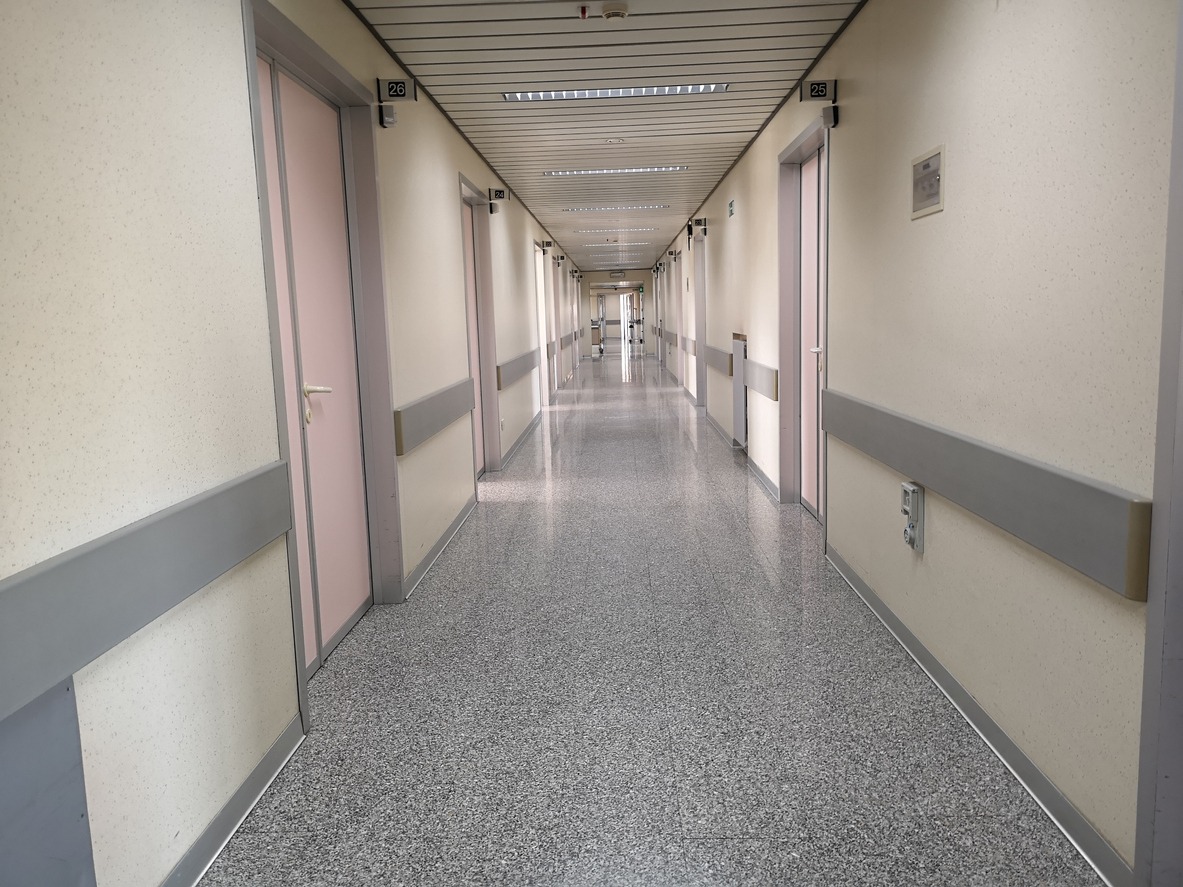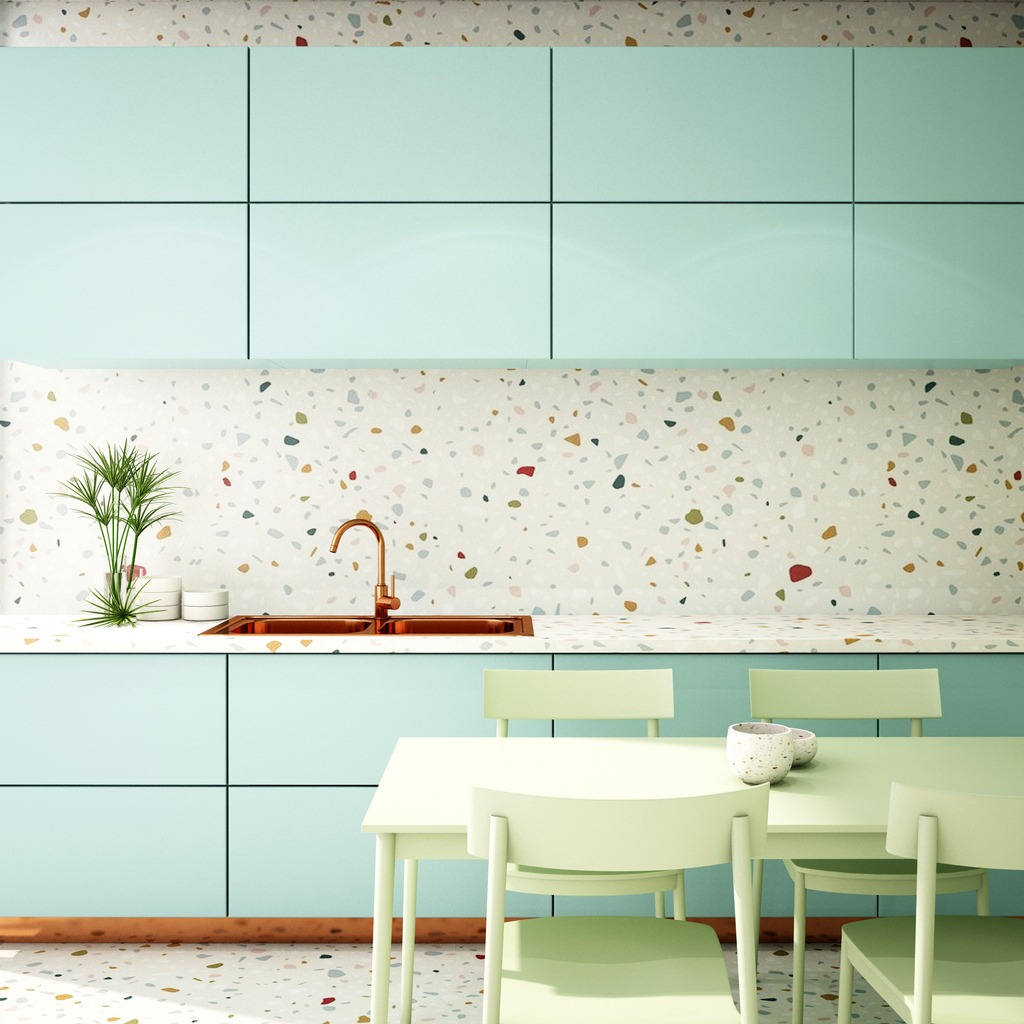If you’re someone who loves mid-century aesthetics, chances are you’re already a fan of terrazzo tile, even if the name doesn’t ring a bell. Terrazzo brings the high-end look of materials like granite, quartz, and marble to a budget-friendly design by blending these fancy materials’ chips with an affordable cement binder. What’s more, it boasts remarkable durability, able to withstand decades of heavy use, even in demanding environments.
Next time you’re in a bustling airport, a busy office lobby, or even on the Hollywood Walk of Fame, take a moment to look down at the floor, and you’ll likely spot terrazzo. If it can endure in these high-traffic places, you can trust that it’s a long-term investment worth considering for your home.
Get to know this popular and durable material in this article.
What is Terrazzo?
Terrazzo is a composite material used for flooring and wall treatments. It involves combining chips of marble, quartz, granite, glass, or other suitable materials with a binding agent, which can be cementitious (for chemical bonding), polymeric (for physical bonding), or a mix of both. Often, metal strips are used to divide sections, mark changes in color or material, or create patterns. Additional chips may be sprinkled on top before it sets. After curing, it’s ground and polished to achieve a uniformly textured surface.
The term “terrazzo” comes from the Latin word “terra,” meaning ground. This ancient-inspired material lends an artisanal touch to interior spaces. It can be poured by hand or precast into blocks that are then cut to size. Restaurants and hotels frequently use this robust material in high-traffic areas like bars and lobbies, but it’s equally suited for residential settings.
Terrazzo is favored for flooring, walls, and accent pieces such as tables, backsplashes, and outdoor patios. It comes in a variety of colors and designs, often available as ready-made tiles. When adequately sealed for water resistance, it can be applied in various parts of your home, including the bathroom and kitchen. There are numerous reasons to appreciate terrazzo—it’s durable, visually appealing, and cost-effective. Generally more affordable than granite and marble, it offers an eye-catching alternative that won’t break the bank.
The History of Terrazzo
Terrazzo boasts a fascinating history. Its origins reach back more than 500 years to Italy, where marble was the leading material of choice. Craftsmen in Venice would gather leftover marble fragments from their high-end projects and, for their own homes and terraces, place them side by side in a clay mortar base.
Terrazzo is also closely tied to a technique known as “seminato,” which means “seed.” Workers would toss large marble chips into wet cement, which was later ground and polished. Together, these two methods birthed the basic form of terrazzo, where stone pieces are bonded to a cement bed.
While Italians usually get the credit, with Venetians often hailed as the inventors of terrazzo, archaeologists have uncovered evidence of similar floors in Turkish ruins dating back a whopping 10,000 years.
Fast-forward to today and the majority of terrazzo installations are epoxy-based. Introduced in the 1970s, epoxy offered advantages over cement systems, including faster installation, greater design flexibility, and longer lifecycles. According to the National Terrazzo and Mosaic Association (NTMA), epoxy terrazzo is considered the top-notch thin-set system, remaining one of the most durable and cost-effective flooring options. Thanks to the addition of epoxy resin, today’s terrazzo isn’t limited to traditional stone; it can embrace all kinds of materials, from metal and glass to rubber and plastic.
These days, you’ll stumble upon terrazzo infused with shards of metal, glass, rubber, plastic, and more. With a vast array of materials at its disposal, terrazzo’s potential for aesthetics seems almost boundless. This versatility has not only won over designers of all stripes but has also opened up new avenues for bringing it into homes without the need for a professional contractor.
The Evolution of Aggregates
In the early days, marble and granite were the traditional aggregate choices, cherished for their beauty and widespread availability from quarries worldwide. Mother of Pearl, coral, shell, and pebbles were also used regionally but have now found homes all around the globe. Epoxy, with its expanded binding capabilities, paved the way for new materials to join the aggregate party. These newcomers include recycled glass, mirrors, plastic, porcelain, and concrete.
Regardless of the aggregate material, the process remains much the same, whether it’s sourced from a quarry, the ocean, or a recycling center. The aggregates are crushed and screened to ensure consistent sizing, ranging from the tiniest #00 at 1/16 inch to the beefier #8 at 1 1/8 inches. Afterward, these aggregates are neatly packaged in bags of precise weight.
Where Do You Usually See Terrazzo?
You will most likely come across this stylish flooring daily – you may not just know it. Here are some common places where you might encounter these floors:
Airports and Transportation Hubs
Airports have embraced terrazzo to help guide travelers smoothly through terminals and concourse areas. Vibrant colors and patterns serve as visual cues, assisting passengers to navigate their way while reflecting the city’s culture through the floor design.
Terrazzo’s major perk for airports? It’s low-maintenance and built to last, saving on repair and upkeep costs despite the constant foot traffic.
Schools and Universities
Research shows that good design, including materials like terrazzo, can enhance academic performance. In elementary schools, lively colors create an engaging atmosphere for young learners, while school logos boost school spirit. This is why terrazzo is most often used in school lobbies, where the school emblem is designed on the floor.
Terrazzo’s durability and low maintenance keep costs down and contribute to better indoor air quality, creating a healthier learning environment.
Hospitals and Healthcare Facilities
Terrazzo offers a hygienic flooring choice for hospitals, as it is nonporous and resistant to bacteria, mold, and mildew growth. Its seamless surface facilitates the movement of wheeled equipment like hospital beds and wheelchairs.
Corporate Offices
In the business world, first impressions matter. Corporate headquarters often feature terrazzo floors to create a welcoming and calming environment.
Terrazzo’s positive impact extends to employee productivity, and companies can reinforce their brand by incorporating corporate logos and colors in the office design.
Homes and Apartments
Homeowners appreciate the customization options for their kitchens, bathrooms, and living spaces, including floors, countertops, backsplashes, and shower stalls.
The longevity and low maintenance of terrazzo make it a smart investment for homeowners seeking both style and practicality.
As you become more familiar with terrazzo, you’ll start spotting it in various places beyond these examples, including restaurants, hotels, retail stores, and theaters. Its versatility and enduring charm make it a standout choice in diverse settings.
Why Is Terrazzo a Fantastic Material to Use for Your Home?
Terrazzo isn’t just super durable; it’s also a champ against water, mold, and stains. This makes it a fantastic choice for flooring in places like kitchens, bathrooms, mudrooms, and even outdoor areas. But why stop at the floor? Terrazzo can venture where you’d usually think of delicate ceramic tiles, like in showers, bathtubs, and swimming pools.
Are you dreaming of luxurious marble or granite countertops, but your budget is holding you back? Terrazzo to the rescue! Not only can it save the day, but it also offers an incredible range of colors and designs, giving you the creative freedom to design your dream kitchen. You can even craft your very own custom terrazzo tiles, a worthwhile investment if you plan to admire your terrazzo setup for decades.
Here’s another bonus: cleaning terrazzo is a breeze; there is no need for harsh chemicals or special treatments. That kind of quality might just convince you to bring terrazzo to any surface you want.
Even if you’re renting or not diving into major home renovations, you can still infuse your space with the terrazzo look. Consider terrazzo furniture like tables or decorative accents like vases and planters.
Different Types of Terrazzo
Terrazzo installation is a system with various materials determining the thickness, weight, and shine of the final product. When it comes to flooring, the choice of system is crucial in achieving the desired weight and style for your space. Here are some common terrazzo systems:
- Epoxy/Thin-set Epoxy: Slim and sturdy; perfect for both commercial and residential settings.
- Polyacrylate: Breathable material that uses small chips; ideal for outdoor use.
- Sand Cushion: Reinforced with wire, heavy-duty; great for high-traffic areas.
- Monolithic: Lightweight and budget-friendly; suitable for indoor spaces like schools, malls, and busy areas.
- Bonded: Thin and heavy. Professional installation is recommended and limited in terms of colors and sizes.
- Rustic: Suited for outdoor installation. Its rough surface provides slip resistance, making it great for pools and patios.
Installing Terrazzo Tiles
It’s often wise to enlist a professional terrazzo installer for sizable spaces or intricate patterns to ensure a flawless result. However, if you’re feeling handy and up for a flooring project, installing terrazzo tiles can be quite rewarding. Here are some straightforward steps to guide you through the process:
Measure the Area
Begin by measuring the space where you plan to lay the terrazzo tiles. Multiply the length by the width to determine the total area. Ensure you acquire enough tiles to cover the area, and consider getting a few extras to accommodate cuts or personal design preferences.
Prepare the Surface
If there’s existing flooring, remove it. Depending on the condition of the surface, you might need a leveling compound to ensure it’s flat and even. The goal is to have a clean, level, and sufficiently smooth surface for the terrazzo tiles.
Adhere the Tiles
Apply a layer of adhesive onto the prepared surface, then carefully place the tiles, ensuring they fit neatly.
Finish the Terrazzo Flooring
Once the tiles are in place, press them down firmly to set them securely. Repeat this process until you’ve covered your desired area with terrazzo tiles. After allowing two to three days for the installation to set, it’s time to grout the joints and fill any gaps. Finally, protect and enhance the floor by applying a water-based or permanent sealer.
Unless you’re well-versed in flooring projects, it’s often advisable to bring in a professional flooring expert to ensure that every aspect of your terrazzo system is correctly executed. However, for smaller DIY ventures like backsplashes, tables, or terrazzo decor, there are plenty of online tutorials to inspire your creative endeavors.
Terrazzo Maintenance Tips
Terrazzo is easy to maintain, especially if properly installed. It naturally boasts durability and a long lifespan. However, like any material, it can develop cracks, stains, or blemishes over time. Here are some essential care tips:
For Terrazzo Countertops:
- Use coasters and potholders to protect against moisture and dark stains that could seep into the surface.
For Terrazzo Floors:
- Regularly sweep, mop, and vacuum to keep your terrazzo floors looking their best.
- Opt for a cleaning solution with a neutral pH balance to remove stains or streaks. Steer clear of harsh chemicals or acidic solutions that might harm the terrazzo.
- To restore that glossy shine, buff the floor with a soft cloth.
Considerations Before Installing Terrazzo
Terrazzo remains a popular choice because it offers a remarkable balance of value and price. It not only creates a lasting first impression but also endures for a lifetime. However, there are a few drawbacks to keep in mind:
- Terrazzo doesn’t retain heat well, which might lead to cold winters.
- In historic homes, terrazzo may contain asbestos, so if it deteriorates or cracks, seek professional help for removal or repairs.
- Terrazzo is designed to last a lifetime, so make sure you truly love it before committing to this material. If you anticipate changing your style soon, consider the time and cost involved in removing terrazzo or having professionals install new flooring over it. To be sure, you can test the terrazzo in a small area before making a permanent decision, as reversing it could be costly.
Frequently Asked Questions about Terrazzo
How Much Does Terrazzo Flooring Cost?
The price of your terrazzo floor hinges on a few factors, primarily the type of aggregate you prefer. Basic stone aggregates are budget-friendly while opting for large marble or quartz chips will drive up the cost significantly.
In addition to the materials, you’ll need the expertise of a professional contractor, and sometimes, subfloor preparation might be necessary. Here’s a ballpark figure to give you an idea:
- For poured terrazzo flooring, expect to invest between $20 and $100 per square foot.
- If you’re considering terrazzo tile installation, the cost typically falls between $15 and $30 per square foot.
Keep in mind that these estimates can fluctuate depending on various factors, so it’s wise to consult with professionals for a precise quote tailored to your specific project.
What’s the Typical Thickness of Terrazzo Flooring?
The thickness of terrazzo flooring can vary slightly depending on the manufacturer and materials used. Generally, terrazzo flooring falls within the 1/2 to 3/4 inches thick range. Thin-set terrazzo floors tend to be around 1/4 to 3/8 inches thick, while sand-cushioned, monolithic, and bonded terrazzo typically measures 1/2 inch. It’s essential to note that these measurements aren’t the only factors to consider. The mortar bed usually sits at about 1 1/2 inches and often rests on a 1/4-inch cushion of sand or asphalt paper.
How Long Can You Expect Terrazzo to Last?
Terrazzo flooring boasts an impressive lifespan, typically ranging from 75 to 100 years and, in some cases, even longer with proper care. It’s no surprise that this flooring type can outlast the building it’s in, which is why both the material and installation often come with a lifetime guarantee.
How Do You Maintain the Shine of Terrazzo Floors?
One of the appealing features of terrazzo floors is their natural shine. Maintaining this shine is relatively straightforward. You can opt for a professional floor polisher, which typically costs between $3 and $7 per square foot, if you prefer a hands-off approach.
For DIY enthusiasts, follow these steps:
- Start by mopping the floor with a microfiber mophead and a pH-neutral cleaner suitable for terrazzo.
- Allow the floor to dry, then apply a thin layer of terrazzo sealant.
- Once the sealant dries, proceed to polish the floor using terrazzo polishing powder. It will form a slurry, resembling a muddy appearance.
- Mop the floor again after most of the powder settles. If the shine isn’t to your liking, continue rubbing with the powder until you achieve the desired gloss.
Can You Repair Terrazzo?
Terrazzo can sustain damage due to incorrect installation or occasional accidents like heavy objects being dropped or dragged across it. Fortunately, terrazzo repairs are possible, whether through professional services or as a DIY project.
For professional repairs, specialized companies can restore terrazzo floors at an average cost of $5 to $8 per square foot, depending on the extent of the damage.
For DIY repairs:
- To fix small cracks, mix coloring and epoxy, then fill the cracks with a toothpick. Allow 24 hours for it to fully set.
- Larger cracks require a paint stripper to remove the surrounding sealant. Apply an oil-based paint that matches the terrazzo color and seal the area once dry.
- For in-situ poured floors, sand the damaged area, apply new material as a patch, let it dry for 24 hours, and then sand it down with 40-grit sandpaper until level with the rest of the floor before sealing it.








